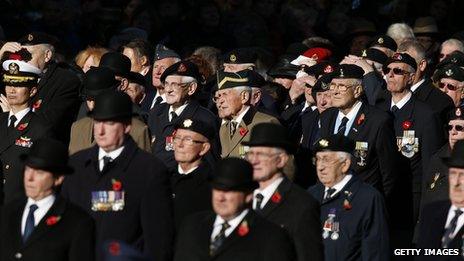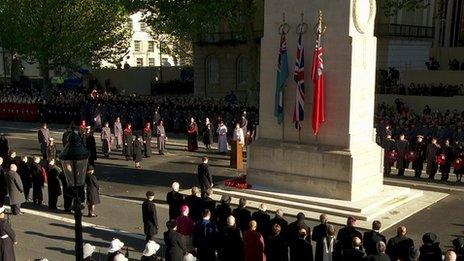Silence and solemnity at the Cenotaph
- Published
The Queen laid the first wreath at the Cenotaph, as Nicholas Witchell reports
Under a startlingly blue sky and in bright sunshine they stood silent around Edwin Lutyens' extraordinary Cenotaph, the memorial to the dead of almost a century of wars and conflicts which has stood in mute testimony to the sacrifice of generations in London's Whitehall.
As the 11 o'clock chimes of Big Ben died away the wind suddenly got up.
The flag atop the Foreign Office stiffened, and the two-minute silence was broken by the rustling of the trees as a few stray leaves blew down past the great white bulk of the Ministry of Defence.
Scarcely anyone or anything else moved as thousands stood in solemn contemplation.
Courage, service and sacrifice
The Queen, top military brass, politicians led by Prime Minister David Cameron, and high commissioners from more than 40 Commonwealth countries, representative contingents from the armed forces drawn up in hollow square around the Cenotaph - and, most moving of all, the 10,000 veterans and civilians massed along Whitehall as far as the eye could see towards Trafalgar Square, a sea of contrasting caps and berets, gathered here to remember fallen comrades.
Then the gun fired in St James's Park and the buglers sounded the Last Post to mark the end of the silence.
It is a familiar scene, a tradition inaugurated in 1919 and faithfully repeated ever since, a ritual that scarcely changes.
It is one I have watched many times on television.
But only when you stand in Whitehall do you fully grasp the way the silence and solemnity continue for several minutes more, while the Queen and other members of the Royal Family and the service chiefs lay the first wreaths of poppies at the foot of the Cenotaph.
Only when the massed bands of the Guards Division strike up Beethoven's Funeral March No 1 and the prime minister steps forward to lay his wreath is that remarkable silence finally broken.
And then perhaps the most moving part of the whole day.
The bands set aside the solemn music and strike up a selection of familiar, jaunty march tunes, and those 10,000 veterans, in more than 200 contingents, begin parading past the Cenotaph, each group bearing its wreath.

The military veterans lined Whitehall ahead of the annual service
Young, old and very old, some in uniform, some in wheelchairs, proudly recalling their rusty parade ground drill, and organised under the auspices of the Royal British Legion, they march in the sunshine as the Princess Royal takes the salute as the march ends on Horse Guards Parade.
And each contingent tells its own story: Of courage, service and sacrifice.
On television David Dimbleby observed the numbers marching seemed to grow greater each year.
So too it seems do the crowds of bystanders. The two-minute silence may no longer bring Britain's streets to a hushed standstill, but around Whitehall itself ordinary members of the public still come in large numbers to take part, if only by watching from the sidelines.
As the veterans dispersed for lunch thousands of people filled the street, thronging around the Cenotaph.

Wreaths of poppies are laid at the Cenotaph before the march past begins
- Published10 November 2013
- Published10 November 2013
- Published10 November 2013
- Published9 November 2013